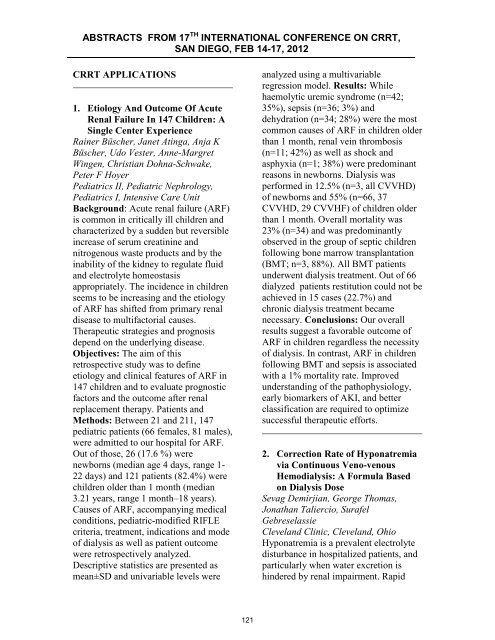ABSTRACTS from 16th International COnference on ... - CRRT Online
ABSTRACTS from 16th International COnference on ... - CRRT Online
ABSTRACTS from 16th International COnference on ... - CRRT Online
You also want an ePaper? Increase the reach of your titles
YUMPU automatically turns print PDFs into web optimized ePapers that Google loves.
<str<strong>on</strong>g>ABSTRACTS</str<strong>on</strong>g> FROM 17 TH INTERNATIONAL CONFERENCE ON <strong>CRRT</strong>,<br />
SAN DIEGO, FEB 14-17, 2012<br />
<strong>CRRT</strong> APPLICATIONS<br />
1. Etiology And Outcome Of Acute<br />
Renal Failure In 147 Children: A<br />
Single Center Experience<br />
Rainer Büscher, Janet Atinga, Anja K<br />
Büscher, Udo Vester, Anne-Margret<br />
Wingen, Christian Dohna-Schwake,<br />
Peter F Hoyer<br />
Pediatrics II, Pediatric Nephrology,<br />
Pediatrics I, Intensive Care Unit<br />
Background: Acute renal failure (ARF)<br />
is comm<strong>on</strong> in critically ill children and<br />
characterized by a sudden but reversible<br />
increase of serum creatinine and<br />
nitrogenous waste products and by the<br />
inability of the kidney to regulate fluid<br />
and electrolyte homeostasis<br />
appropriately. The incidence in children<br />
seems to be increasing and the etiology<br />
of ARF has shifted <str<strong>on</strong>g>from</str<strong>on</strong>g> primary renal<br />
disease to multifactorial causes.<br />
Therapeutic strategies and prognosis<br />
depend <strong>on</strong> the underlying disease.<br />
Objectives: The aim of this<br />
retrospective study was to define<br />
etiology and clinical features of ARF in<br />
147 children and to evaluate prognostic<br />
factors and the outcome after renal<br />
replacement therapy. Patients and<br />
Methods: Between 21 and 211, 147<br />
pediatric patients (66 females, 81 males),<br />
were admitted to our hospital for ARF.<br />
Out of those, 26 (17.6 %) were<br />
newborns (median age 4 days, range 1-<br />
22 days) and 121 patients (82.4%) were<br />
children older than 1 m<strong>on</strong>th (median<br />
3.21 years, range 1 m<strong>on</strong>th–18 years).<br />
Causes of ARF, accompanying medical<br />
c<strong>on</strong>diti<strong>on</strong>s, pediatric-modified RIFLE<br />
criteria, treatment, indicati<strong>on</strong>s and mode<br />
of dialysis as well as patient outcome<br />
were retrospectively analyzed.<br />
Descriptive statistics are presented as<br />
mean±SD and univariable levels were<br />
analyzed using a multivariable<br />
regressi<strong>on</strong> model. Results: While<br />
haemolytic uremic syndrome (n=42;<br />
35%), sepsis (n=36; 3%) and<br />
dehydrati<strong>on</strong> (n=34; 28%) were the most<br />
comm<strong>on</strong> causes of ARF in children older<br />
than 1 m<strong>on</strong>th, renal vein thrombosis<br />
(n=11; 42%) as well as shock and<br />
asphyxia (n=1; 38%) were predominant<br />
reas<strong>on</strong>s in newborns. Dialysis was<br />
performed in 12.5% (n=3, all CVVHD)<br />
of newborns and 55% (n=66, 37<br />
CVVHD, 29 CVVHF) of children older<br />
than 1 m<strong>on</strong>th. Overall mortality was<br />
23% (n=34) and was predominantly<br />
observed in the group of septic children<br />
following b<strong>on</strong>e marrow transplantati<strong>on</strong><br />
(BMT; n=3, 88%). All BMT patients<br />
underwent dialysis treatment. Out of 66<br />
dialyzed patients restituti<strong>on</strong> could not be<br />
achieved in 15 cases (22.7%) and<br />
chr<strong>on</strong>ic dialysis treatment became<br />
necessary. C<strong>on</strong>clusi<strong>on</strong>s: Our overall<br />
results suggest a favorable outcome of<br />
ARF in children regardless the necessity<br />
of dialysis. In c<strong>on</strong>trast, ARF in children<br />
following BMT and sepsis is associated<br />
with a 1% mortality rate. Improved<br />
understanding of the pathophysiology,<br />
early biomarkers of AKI, and better<br />
classificati<strong>on</strong> are required to optimize<br />
successful therapeutic efforts.<br />
2. Correcti<strong>on</strong> Rate of Hyp<strong>on</strong>atremia<br />
via C<strong>on</strong>tinuous Veno-venous<br />
Hemodialysis: A Formula Based<br />
<strong>on</strong> Dialysis Dose<br />
Sevag Demirjian, George Thomas,<br />
J<strong>on</strong>athan Taliercio, Surafel<br />
Gebreselassie<br />
Cleveland Clinic, Cleveland, Ohio<br />
Hyp<strong>on</strong>atremia is a prevalent electrolyte<br />
disturbance in hospitalized patients, and<br />
particularly when water excreti<strong>on</strong> is<br />
hindered by renal impairment. Rapid<br />
121
















